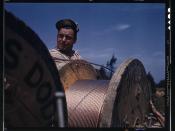Husky injection Molding Systems: Shift in Strategy
Husky Injection Molding Systems is a global supplier of injection molding systems for the plastic industry serving customers in over 70 countries from 33 service and sales offices in 25 countries. (1) Husky announced a shift in its business strategy, in which they plan to quit production of closure molds and close their industrial mold shop located in Auburn, Massachusetts. (2) They intend to focus on their core businesses of making machines and molds for the production of PET (polyethylene terephthalate) preforms. (3) They also plan to add bottle development services to further take advantage of the growing PET market. (4)
A Short History of Husky Leading to the Shift in Strategy.
Robert Schad who emigrated from southwestern Germany in 1951 to Canada founded Husky in 1953. As an engineer he started the business designing and manufacturing snowmobiles and one of his first models the "Huskymobile" was a complete failure.
To remain in business he was forced to perform machining jobs for other customers, which eventually led him into the injection mold business. Schad was able to enter the highly competitive injection mold manufacturing business by under bidding the competition by more than 50% on his first job, in which he lost money, but it gave him the start he needed. "By the late 1950's Schad and Husky had established a reputation as a high quality maker of plastic injection molds." (5)
"In 1961, Husky produced its first injection molding machine which was a highly specialized, high speed system to produce thin wall containers." (6) Sales started off slow nearly sending Husky into bankruptcy, but by the mid 1960s sales picked up because customers liked the fully integrated system of thinwall mold, injection molding machine, and product handing equipment that was offered.
In 1973-74 Husky once again found that they were on the brink of bankruptcy, which was fueled by the global oil shortage that caused the price of plastic resin to soar. This time they were saved by Owens-Illinois, a major container manufacturer, that asked Husky to work with them on PET packaging. "A new line of molding systems, tailored for production of PET bottle preforms pulled Husky out of its crisis by the end of the 1970s. Husky introduced machines and molds to produce PET preforms, just as the soft drink companies began to start using plastic bottles." (7) Husky established itself as a leading firm in the preform niche and by 1995 their molds and injection molding machines were responsible for approximately 60% of the total world's supply of preforms. "Profits from this area allowed Husky to expand into other product lines and additional countries during the 1980s and early 1990s." (8)
In the first half of the 1990s Husky experienced explosive growth where revenues grew from $250 million in 1992 to more than $600 million in 1995 and the company had a return on equity approaching 40%. Then suddenly in late 1995 their success dropped dramatically as machine demand plummeted and competitors entered Husky's most lucrative markets with equipment sold at very low prices. (9)
"By January of 1996, Husky's management team was convinced that it had to alter the firm's strategy in a fundamental way." (10) Husky had large advantage in the technically demanding PET preform mold market and also made molds for the production of closures, however these markets were easily imitated by smaller injection mold manufacturers. After Schad and his management team reviewed the options they decided to quit production of closure molds and concentrate on the PET technology.
Why did Husky Choose this Strategy?
Husky had been in the injection molding business for more than 35 years and had experienced several periods where business was extremely bad. Each time they were able to buckle down and move into areas of manufacturing that were the most comfortable and more profitable. Husky was aware that the injection molding machine business was becoming highly competitive and some of the mold manufacturing business was equally competitive. Therefore they returned to the PET molds and injection molding machines that serviced the PET business, which led them to the success that they were recently experiencing. They knew that they were the leaders in this field and it was a logical decision to place the majority of its resources to support it. Also at this time there were rumbles in the industry that there were new markets being developed for PET, which indicated future business for the mold makers and injection molding machine manufacturers.
What happened in the PET business after the decision was made?
In 1998, PET remained the fastest growing plastic material where consumption climbed from 3.4 billion pounds, up from 3.15 billion pounds in 1997. This rapid growth was due to two items, declining raw material prices and increased demand because of new markets for PET containers. PET has moved into two new markets, hot-filled juice bottles (up to 1940 F.) and water bottles, which previously were made from glass or high-density polyethylene (HDPE). (11)
Although my current employer, Graham Packaging had become one of the largest plastic bottle manufacturers in the world, they had not been able to move into the highly competitive PET market. Graham had worked with Husky in the past when Graham started producing caps and pour spouts for the laundry detergent industry in 1988. In 1997, Graham was the first container manufacturer to begin making bottles for the hot-fill juice market. This new technology permitted Graham an entry into the PET market and because of the past relationship with Husky, they were chosen to provide both injection molding machines and molds. Over the last four years Graham has purchased from Husky more than 40 injection molding machines and greater than 50 PET molds to be able to service the hot-fill juice market.
Husky has introduced a new design injection molding machine to be used for the manufacturing of PET preforms. The unusual Index series consists of a two-platen preform injection machine that "uses a four-station rotary turret on the moving platen to perform simultaneous injection and external cooling without the need for a robot." (12) According to Robert Schad, President and CEO of Husky, "The newly developed Index system for manufacturing PET preforms has received strong market acceptance and has further strengthened our competitive position." (13)
Another innovation that Husky introduced concerned the design of the PET molds where they were able to utilize one mold to produce multiple products. "High-output PET preform molding systems are very efficient for manufacturing large numbers of identical parts", but with the current need to have quick changeovers and multiple product packages the need for this new technology was apparent. With the cost of a large PET mold getting close to half a million dollars, it was advantageous for Husky to design the mold to incorporate interchangeable parts that can make different preforms from the same mold set. This flexibility offers enormous cost savings if it is incorporated when the mold is first manufactured. (14)
There were also indications that the beer industry was beginning to experiment with the use of PET bottles. In the past PET was not considered for the brewing industry because the original PET bottles could only provide a nine-day shelf life, which was totally unacceptable. Many of the PET processors began experimenting with different processes to improve the shelf life for a PET container. As of April 1999 there are at least nine different plastic beer-bottle programs under development. (15) When this technology finally evolves into a viable container material for the brewing industry, the demand for molds and injection molding machines will explode trying to fill even part of the 300-billion unit global annual consumption of beer containers in glass and aluminum. (16)
Recent Results and Statistics
The 1998 sales reached a new high of $762 million, which was a 21.6% increase from the previous year. (17) According to Robert Schad, "the Index system will become a meaningful part of our sales mix in Fiscal 2000 and our PET market share will increase as the market firms up in the second half of 1999". (18) The PET market in general for 1998 started slow, but rose sharply in the second half to pull the annual growth rate up to 20.3%. (19) As the facts indicate, Husky made the right decision to concentrate on the PET market and because of it's engineering expertise, manufacturing facilities, service, and culture found at Husky, they will continue to hold a competitive advantage for a long time.
Additional Sites:
http://www.plasticstechnology.com/
http://www.modplas.com
http://www.immnet.com/
http://www.packagingdigest.com/
http://www.transium.com
http://www.napcor.com/
References
1. "Husky Injection Molding Systems Ltd. Closes Initial Public Offering" November 9, 1998. http://www.husky.on.ca/Sc/Presclos.htm
2. "Husky announces a shift in its strategy", Modern Plastics, February 1997. http://www.transium.com/backgrounder/profile2.html?profile=company&item=Husky+Injection+Molding+Systems&q=&qi=%2Bkco%3A%22Husky+Injection+Molding+Systems%22,%2Bkct%3A%22CORPORATE+STRATEGY%22&stag=-a&page=1&r=1.tbusref.I47089155
3. "Husky takes new roads in supply of equipment", Modern Plastics, November 1998. http://www.transium.com/backgrounder/profile2.html?profile=company&item=Husky+Injection+Molding+Systems&q=&qi=%2Bkco%3A%22Husky+Injection+Molding+Systems%22,%2Bkct%3A%22CORPORATE+STRATEGY%22&stag=-a&page=1&r=1.tbusref.I50376455
4. "Husky announces a shift in its strategy", Op. cit.
5. Rivkin,Jan "Husky Injection Molding Systems", Harvard Business School, May 14, 1999.
6. Ibid.
7. Ibid.
8. Ibid.
9. Ibid.
10. Ibid.
11. Masito, Richard C. "Flexible, rigid packaging markets resin use tops 27 billion lb. annually" Modern Plastics, 1999. http://modplas.com/encyclopedia/articles/articles_industry_packaging.htm
12. Knights, Mikell " New PET preform machines pack more capacity in less space", Plastics Technology, June. http://209.35.124.84/archive_arts/161.htm
13. "Husky Injection Molding Systems LTD Expects Earnings to vary from analysts' estimates", March 5, 1999. http://www.husky.on.ca/Sc/Pr-stock.htm
14. Dravetz, Reinhart "Build More Flexibility into your PET Preform Molds", Plastics Technology, February 1999, p. 55-57. http://209.35.124.84/archive_arts/February99/299_55.HTM
15. Knights, Mikell "Plastic Beer Bottles Are No Longer Just a Dream", Plastics Technology, April 1999, p. 39 - 41. http://209.35.124.84/archive_arts/April99/499_39.HTM
16. Ibid.
17. Husky Injection Molding Systems Ltd. - Hoover's Online http://www.hoovers.com/co/capsule/5/0,2163,56225,00.html
18. "Husky Injection Molding Systems LTD Expects Earnings to vary from analysts' estimates", Op. cit.
19. Your Business Outlook --"99 Will Cool Sizzling Growth in PET Bottles", Plastics Technology, March 1999, p.77. http://209.35.124.84/archive_arts/March99/399_77.htm


